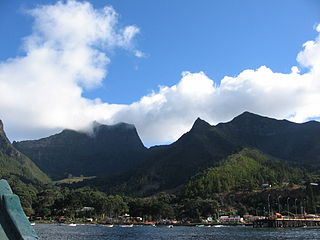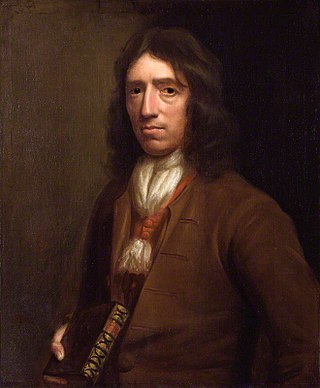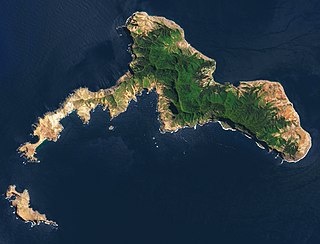
Alexander Selkirk was a Scottish privateer and Royal Navy officer who spent four years and four months as a castaway (1704–1709) after being marooned by his captain, initially at his request, on an uninhabited island in the South Pacific Ocean. He survived that ordeal, but died from tropical illness years later while serving as a lieutenant aboard HMS Weymouth off West Africa.

The Juan Fernández Islands are a sparsely inhabited series of islands in the South Pacific Ocean reliant on tourism and fishing. Situated 670 km off the coast of Chile, they are composed of three main volcanic islands: Robinson Crusoe, Alejandro Selkirk and Santa Clara. The group is part of Insular Chile.

Robinson Crusoe is an English adventure novel by Daniel Defoe, first published on 25 April 1719. Written with a combination of epistolary, confessional, and didactic forms, the book follows the title character after he is cast away and spends 28 years on a remote tropical desert island near the coasts of Venezuela and Trinidad, encountering cannibals, captives, and mutineers before being rescued. The story has been thought to be based on the life of Alexander Selkirk, a Scottish castaway who lived for four years on a Pacific island called "Más a Tierra" which was renamed Robinson Crusoe Island in 1966. Pedro Serrano is another real-life castaway whose story might have inspired the novel.

William Dampier was an English explorer, pirate, privateer, navigator, and naturalist who became the first Englishman to explore parts of what is today Australia, and the first person to circumnavigate the world three times. He has also been described as Australia's first natural historian, as well as one of the most important British explorers of the period between Sir Francis Drake and Captain James Cook ; he "bridged those two eras" with a mix of piratical derring-do of the former and scientific inquiry of the latter. His expeditions were among the first to identify and name a number of plants, animals, foods, and cooking techniques for a European audience, being among the first English writers to use words such as avocado, barbecue, and chopsticks. In describing the preparation of avocados, he was the first European to describe the making of guacamole, named the breadfruit plant, and made frequent documentation of the taste of numerous foods foreign to the European palate at the time, such as flamingo and manatee.

Marooning is the intentional act of abandoning someone in an uninhabited area, such as a desert island, or more generally to be marooned is to be in a place from which one cannot escape. The word is attested in 1699, and is derived from the term maroon, a word for a fugitive slave, which could be a corruption of Spanish cimarrón, meaning a household animal who has "run wild". Cimarrón in turn may be derived from the Taino word símaran (“wild”), from símara (“arrow”).
George Shelvocke was an English Royal Navy officer and later privateer who in 1726 wrote A Voyage Round the World by Way of the Great South Sea based on his exploits. It includes an account of how his second captain, Simon Hatley, shot an albatross off Cape Horn, an incident which provided the dramatic motive in Samuel Taylor Coleridge's poem The Rime of the Ancient Mariner.

Woodes Rogers was an English sea captain, privateer and colonial administrator who served as the governor of the Bahamas from 1718 to 1721 and again from 1728 to 1732. He is remembered as the captain of the vessel that rescued marooned Scottish sailor Alexander Selkirk, whose plight is generally believed to have inspired Daniel Defoe's novel Robinson Crusoe. Rogers came from an experienced seafaring family, grew up in Poole and Bristol, and served a marine apprenticeship to a Bristol sea captain. His father, who held shares in many ships, died when Rogers was in his mid-twenties, leaving Rogers in control of the family shipping business.

Robinson Crusoe Island is the second largest of the Juan Fernández Islands, situated 670 km west of San Antonio, Chile, in the South Pacific Ocean. It is the more populous of the inhabited islands in the archipelago, with most of that in the town of San Juan Bautista at Cumberland Bay on the island's north coast. The island was formerly known as Más a Tierra.

Alejandro Selkirk Island, previously known as Más Afuera and renamed after the marooned sailor Alexander Selkirk, is the largest and most westerly island in the Juan Fernández Archipelago of the Valparaíso Region of Chile. It is situated 180 km west of Robinson Crusoe Island in the southeastern Pacific Ocean.

Queen Anne's Revenge was an early-18th-century ship, most famously used as a flagship by Edward Teach, better known by his nickname Blackbeard. The date and place of the ship's construction are uncertain, and there is no record of its actions prior to 1710 when it was operating as a French privateer under the name La Concorde. Surviving features of the ship's construction strongly suggest it was built by French shipwrights, based on differences in fastening patterns in the late 17th and early 18th centuries. After several years of service by French sailors, she was captured by Blackbeard in 1717. Blackbeard used the ship for less than a year, but captured numerous prizes using her as his flagship.
Cinque Ports was an English ship whose sailing master was Alexander Selkirk, generally accepted as a model for the fictional Robinson Crusoe. The ship was part of a 1703 expedition commanded by William Dampier, who captained the accompanying ship, the 26-gun St George with a complement of 120 men.

The archaeology of shipwrecks is the field of archaeology specialized most commonly in the study and exploration of shipwrecks. Its techniques combine those of archaeology with those of diving to become Underwater archaeology. However, shipwrecks are discovered on what have become terrestrial sites.
Jeremiah Cocklyn, better known by the name Thomas Cocklyn, was an English pirate known primarily for his association with Howell Davis, Olivier Levasseur, Richard Taylor, and William Moody.
Will was a Miskito pirate from the Misquito Coast, then part of the Spanish Main. He was left behind on the uninhabited Robinson Crusoe Island, surviving there alone for more than three years. It is possible that Will became the inspiration for Man Friday, the cannibal character in Daniel Defoe's novel Robinson Crusoe.

Godfrey Morgan: A Californian Mystery, also published as School for Crusoes, is an 1882 adventure novel by French writer Jules Verne. The novel tells of a wealthy young man, Godfrey Morgan, who, with his deportment instructor, Professor T. Artelett, embark from San Francisco, California, on a round-the-world ocean voyage. They are cast away on an uninhabited Pacific island, where they must endure a series of adversities. Later, they encounter an African slave, Carefinotu, brought to the island by cannibals. In the end, the trio manage to work together and survive on the island.

Benjamin Morrell was an American sea captain, explorer and trader who made a number of voyages, mainly to the Atlantic, the Southern Ocean and the Pacific Islands. In a ghost-written memoir, A Narrative of Four Voyages, which describes his sea-going life between 1823 and 1832, Morrell included numerous claims of discovery and achievement, many of which have been disputed by geographers and historians, and in some cases have been proven false. He ended his career as a fugitive, having wrecked his ship and misappropriated parts of the salvaged cargo.
Simon Hatley was an English sailor involved in two hazardous privateering voyages to the South Pacific Ocean. On the second voyage, with his ship beset by storms south of Cape Horn, Hatley shot an albatross, an incident immortalised by Samuel Taylor Coleridge in his 1798 poem The Rime of the Ancient Mariner.
Thomas Dover (1660–1742), sometimes referred to as "Doctor Quicksilver", was an English physician. He is remembered for his common cold and fever medicine Dover's powder, his work with the poor in Bristol, and his privateering voyage alongside William Dampier and Woodes Rogers that rescued castaway Alexander Selkirk, the real-life inspiration for Robinson Crusoe.

Seven Seas Pirates is a 2012 animated adventure film made in cooperation with Argentina and Chile. It was directed by Uruguayan Walter Tournier, based on a script he wrote in collaboration with Mario Jacob and Enrique Cortés and premiered on Feb. 2, 2012. It was filmed mainly with stop motion, with digital details added in post-production.













